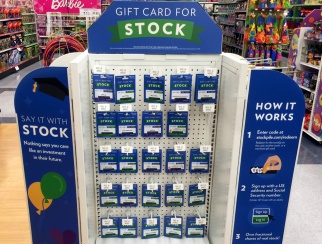This article was published in the September 2016 issue of STORES Magazine.
New program opens the stock market to the masses
Staple items on consumers’ weekly shopping lists are expanding beyond bread, eggs and milk and toward “fractions of Apple” — Apple stock, that is. By adopting a new gift card program, retailers are enabling consumers to invest in stock shares of public companies.
Between channel-blurring and the expansion of omnichannel retail, gift cards are more accessible than ever. U.S.-based gift card sales accounted for $130 billion last year, according to the ninth annual CEB TowerGroup report, a more than 6 percent increase over 2014.

Introduced as a means to offset counterfeit printed gift certificates, gift cards have evolved into a product that guarantees brand sales and upselling opportunities; consumers often spend 20 percent more than the card’s value, according to data from GiftCards.com.
Customers have grown accustomed to purchasing and receiving “closed loop” gift cards that can only be redeemed at the brands listed on the card. They are also reaching for “open loop” cards, or products that run on credit card systems. These cards can be redeemed in stores, online or through other channels that accept the carrier’s products.
Removing friction
The success of the gift card industry is evolving the product into a new category — stock options. That could be the boost needed to augment the 55 percent of Americans currently invested in the stock market, according to Gallup’s annual Economy and Finance Survey, a report conducted in April 2015.
“Between a high cost of entry, commission fees, required account balances ranging between $2,500 and $5,000 and complicated paperwork and account maintenances, there is nothing friendly about stock ownership,” says Dan Schatt, chief commercial officer of brokerage services firm Stockpile. “It was time to make the process frictionless.”
Stockpile offers physical gift cards from public companies including Apple, Tesla and Nike, as well as exchange traded fund cards for shares across Nasdaq and Standard & Poor’s 500.
Stockpile offers physical gift cards from public companies including Apple, Facebook, Tesla, Starbucks and Nike, as well as exchange traded fund cards for shares across Nasdaq, Standard & Poor’s 500, the Dow Jones Industrial Average and even gold. The cards are available in denominations of $25, $50 and $100.
Once a card is redeemed, the stockholder receives a fractional share of the stock in an authentic brokerage account. Known as equity that is less than one full share of stock, fractional shares are usually related to stock splits, dividend reinvestment plans and other corporate actions, yet they typically cannot be acquired from the market.
“Historically, it has been difficult to buy and gift stock, and fractional shares have been hard to transfer,” Schatt says. “This program streamlines how to physically and digitally share stock, and make an investment in someone’s future.”
To redeem the card, recipients log onto Stockpile’s website and type in a personal identification code printed on the card; within 90 seconds they are guided through a brokerage account opening process that enables them to redeem gift cards and manage transactions and stock trades.
Each card has a minimal activation charge, similar to a traditional open loop gift card, to cover credit card fees, trading commission fees and other costs. While the recipient isn’t charged to redeem the card, each stock trade made in their account is subject to a 99-cent fee. The program enables stockholders to keep, buy and sell stock, just as with a traditional brokerage firm.
Paving the road
While cards can be purchased online or through an iPhone app, Stockpile launched a pilot program during the 2015 holiday season in select supermarkets and retail chains including Kmart, Wegmans and Giant Eagle to give the program more traction.
“Customers have enjoyed the convenience of purchasing retailer gift cards at Giant Eagle since 2004, and we were thrilled to introduce a new category to our ‘Gift Card Gallery’ last fall,” says Tina Flowers, vice president of specialty merchandising and in-store banking for Giant Eagle.
While the stores cater to a good cross section of demographics, during this timeframe, “we watched shoppers across varying social criteria [exhibit] similar shopping behaviors,” Schatt says.
Purchased denominations tended to differ across different retailers, but sales velocity was similar. “While Wegmans shoppers often purchased cards in $50 and $100 denominations and Kmart shoppers often purchased $25 cards, all shoppers had similar [consumption] behaviors, purchasing an average of three cards per visit,” Schatt says.
More than 1 million cards were sold during the holiday season overall, and “orders are currently exceeding that for the 2016 graduation season,” he says. “Besides seeing a lift during the holidays and graduation, cards are becoming a gifting option for weddings, birthdays and other occasions. It’s exciting that people are buying the cards all year round.”
“It has become increasingly popular among customers interested in gifting blue chip stock as a modern twist on a savings bond.”
Tina Flowers
Giant Eagle
For Giant Eagle specifically, “the offering has become increasingly popular among customers interested in gifting blue chip stock as a modern twist on a savings bond, or beginning a stock portfolio of their own for a minimal upfront investment,” Flowers says.
More participants have come aboard since the pilot, including Toys “R” Us, Staples and Simon Malls. Many use it for “financial inclusion,” Schatt says, not only among consumers but among their employee base as well. For some, the program is being used as an incentive among the workforce.
Across all retailers, the most popular choices include $50 Apple, Google and Facebook cards, $50 “Index” cards, $25 Tesla cards and $100 Berkshire-Hathaway cards. Demographics of users is also across the board, as 20 percent of account holders are under the age of 18 and 50 percent under 30 years old.
“This product appeals to a young customer base that is looking beyond purchasing ‘stuff,’” Schatt says. “They want something longer lasting that will help their future.”